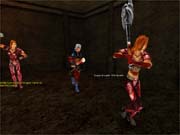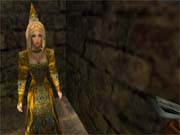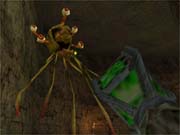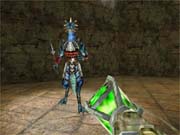Dear Counter-Strike players: If you'd please lay down your submachine guns and flashbangs for a moment, the developers of Legends of Might and Magic have a magic wand they'd like to sell you. At least that seems to be the message behind 3DO's new fantasy team combat game, Legends of Might and Magic. With wizards and warriors replacing terrorists and counterterrorists, the game ends up a mediocre muddle rather than the novel game it could have been.

The gameplay in Legends of Might and Magic should be immediately familiar to shooter fans. This isn't the welcome kind of familiarity, though, but rather the sort that makes you groan, "Don't I already have a better version of this on my hard drive?" Up to 16 players are divided into two teams composed of, unimaginatively, the forces of good and the forces of evil. Each side has three different characters (or character classes) available, including old fantasy standbys, such as paladins and sorceresses. But there aren't enough substantial differences between the characters, since all of them can purchase and use most of the weapons and items. Only a few items are exclusive to specific characters. In fact, the whole character concept feels like an aborted attempt at including role-playing elements in a pure action game. Character classes, whether in a role-playing game or a shooter like Team Fortress Classic, need to have truly distinctive abilities and weaponry to perfectly complement each other and offer a broad variety of playing styles. You won't find that diversity and balance here.
Given the enormous popularity of Counter-Strike, the designers of Legends of Might and Magic apparently didn't hesitate to borrow a few pages--a few chapters, really--from its game design handbook. Gameplay is divided up into rounds, and at the beginning of each one, you purchase more powerful weapons and armor with the gold you've earned by vanquishing foes. Also like in Counter-Strike, you have the crystal ball equivalent of a radar to track other players. There's even a "ghost" mode for players who are sitting out the rest of a round after being killed, à la Counter-Strike.

The four game modes won't set the shooter genre on fire with their originality, though they can still be entertaining. The rescue-the-princess mode has the good team trying to rescue the eponymous damsel in distress from the evil team's lair. To rescue her, you aim at her and press the "use" key, and she'll follow you. In other words, it's the hostage rescue mode from Counter-Strike, with a clueless princess replacing the clueless scientists. The warlord-escape mode offers a medieval variation on the hunted mode from Team Fortress Classic and the assassination mode from Counter-Strike. One player takes the role of a warlord who can't purchase equipment and is escorted to safety by one team while the other tries to bushwhack him. In slay-the-dragon mode, both teams race across the map to see who can kill an ornery dragon first, though players usually end up just killing each other. In the sword-in-the-stone mode, the teams try to see who can first yank a mystical sword from a rock and return it to a designated area.
When you're out rescuing, slaying, and sword stealing, you'll have an arsenal of "might" and "magic" weapons at your disposal. Might armaments include thrown weapons such as knives, axes, and hammers, as well as three crossbows and three bows. Like in Unreal Tournament, the weapons feature primary and secondary attacks, though most secondary attacks make little if any sense, even in a fantasy setting. The secondary knife attack essentially turns the knife into a landmine. The Gatling crossbow seems like a desperate attempt at putting a machine-gun-like weapon in the game. Just like the Redeemer guided missile in Unreal Tournament, the eye bow lets you look through and guide the projectile on the way to its target. In other words, most of the weapons are just poor fantasy versions of those found in other games, and the great majority of them are ranged weapons. Don't expect many blood-spattered melees.
The magic weapons include three rods, three staves, and three wands, though you have to ask, "What's in a name?" They're all just fancy missile weapons in disguise. One fires a magical bolt, another fires a magical beam, and another fires a magical fireball. The three wands offer essentially the same secondary function, a form of clairvoyance that lets you watch enemies from afar. It's as if the designers seemed intent on giving every weapon a secondary mode, even after they ran out of new ideas for them. You can also buy magical one-use scrolls and artifacts, like the overpowered "H.H.G.A." grenade, presumably named after the Holy Hand Grenade of Antioch from Monty Python and the Holy Grail. The weapons are largely silly and boring to use, which is a fatal flaw in any shooter, particularly an action-oriented one like this in which tactics include little more than jumping to dodge or camping to ambush.

If this all sounds like the recipe for a tired, derivative game, it is. Legends of Might and Magic does ship with 20 decent but generally uninspired maps that at least offer solid replay value. You can play offline solo games, though only with a few random monsters that do little but mill around until they spot you. Then, in a display of tactical incompetence, they just charge right at you. That works well in the arcadelike Serious Sam, in which hordes of monsters are constantly rushing you, but here, it's just weak. Furthermore, graphical clipping problems mean that you can sometimes spot parts of monsters through walls, which doesn't exactly add to the suspense, and they can actually kill you this way, too.
The heart of the game is really the online team play, which happily offers more excitement than the offline play. It can be entertaining in short spurts, but it ultimately sags under the weight of unimaginative and overly simplistic gameplay. Thanks to inadequately balanced weapons, armor, and character speed, combat lacks the visceral kick of a game like Quake III Arena, the enjoyably deliberate pace of Tribes 2, or the superb balance between tension-filled stalking and brutal gun battles found in Counter-Strike.

A modified version of the LithTech game engine, most notably featured in the superb No One Lives Forever, at least ensures visuals with lots of rich, vibrant colors--at least on those maps that aren't so dark as to be nearly unplayable. The game offers no gamma/brightness settings to correct this, either. Lighting effects, such as magic wand blasts and flickering torches, offer some vivid displays, and some nice scenic touches, like cattle in a town barn, add a sense of place. The weapon models are bland, though, and the characters look amateurish, with disproportional limbs and distorted faces. They're poorly animated, too--they seem to alternately float or jerk across the ground without ever really coming in contact with it. Some monsters, like the wight, are genuinely spooky when they first charge toward you in the dark, but that's more from the surprise factor than any stunning graphical achievement. Like the graphics, the soundtrack and 3D sound get the job done, but not with any zest or imagination.
If mediocrity and complacency were crimes, Legends of Might and Magic would get tossed in the dungeon. Despite its many blemishes, it's not a bad game overall and can be entertaining for short periods of time. Ultimately, though, it's more disappointing than exciting, and not just because it's transparently modeled after a much better game. It's also an opportunity wasted: With so many excellent science-fiction, counterterrorist, and military shooters available, an imaginative, high-quality fantasy shooter would be a welcome addition to the genre. Unfortunately, Legends of Might and Magic isn't that shooter. The characters and weapons all lazily merge together in a disjointed game design. That is, when a fantasy game's sorceress is ultimately little different from an archer or warrior, you know there's a problem. The paper-thin swords-and-sorcery backdrop isn't used to any real effect either, nor is the Might and Magic license itself. Ultimately, Legends of Might and Magic mightily lacks the magic that turns middling games into great ones.